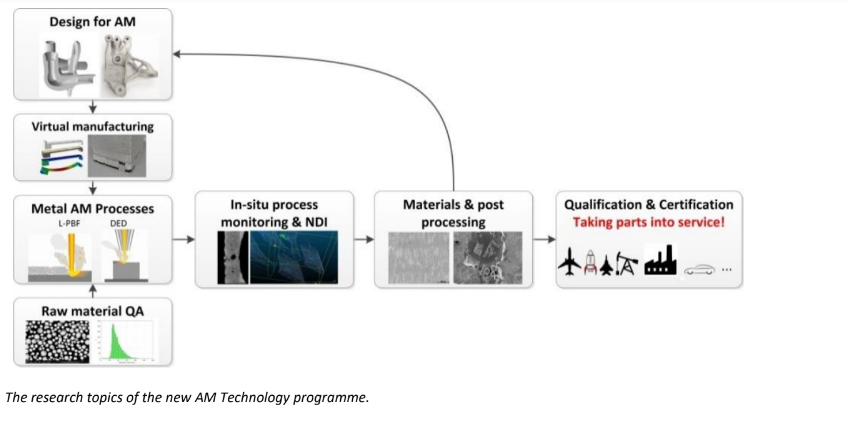As Formnext begins today, running from November 19-22 in Frankfurt, Germany, manufacturers continue to release enticing bits of information regarding what visitors can expect upon touring over 600 exhibitions. BeAM will be at the show in full force, as Vincent Gillett, company President, presents a range of innovative new hardware—and discusses their partnerships in process control with both Precitec and Siemens.
 Headquartered in Strasbourg, France with two Solutions Centers, one in Cincinnati, Ohio and one in Singapore, BeAM is an AddUp company that was founded in 2012. They continue to forge ahead in making directed energy deposition ‘robust, safe, and productive.’ Using thermal energy to meld materials together as they are extruded through a nozzle, DED is a powerful method used in additive manufacturing (AM).
Headquartered in Strasbourg, France with two Solutions Centers, one in Cincinnati, Ohio and one in Singapore, BeAM is an AddUp company that was founded in 2012. They continue to forge ahead in making directed energy deposition ‘robust, safe, and productive.’ Using thermal energy to meld materials together as they are extruded through a nozzle, DED is a powerful method used in additive manufacturing (AM).
BeAM will be presenting their new standoff distance sensor, a control mechanism which helps prevent deviation in process variables, along with simplifying the system. Ultimately, the result is stronger industrial components and prototypes. In partnership with Precitec, they now have access to pioneering research and development efforts. With the advent of further adaptations in Optical Coherence Tomography (OCT) for laser material processing in sensor technology, particle streams and nozzle standoff offer easy measurement, and system control.
Those attending the presentation at Formnext may be surprised to learn that this technology was initially created for welding use, but in working with both Precitec and Siemens, its use has been expanded so that companies like BeAM are able to install the sensors in their 3D printers—already equipped with both Precitec optical heads and the Siemens Sinumerik 840D sl or the new Sinumerik One CNC.
“Thanks to the support from Precitec and Siemens, BeAM will integrate and adapt the control cycle that reads the standoff distance from the sensor and keeps this value constant in a closed-loop control by varying the deposition speed with high frequency,” explains BeAM in their most recent press release sent to 3DPrint.com. “This feature will be available in the BeAM machines in 2020 to process non-reactive as well as reactive materials.”
BeAM has also informed us of a new AM program gearing up at the Netherlands Aerospace Centre, meant to offer a follow-up for participants in additive manufacturing—seeking to create certified metal AM components.
Held at the Metal Additive Manufacturing Technology Centre (MAMTeC) at NLR – Royal Netherlands Aerospace Centre in Marknesse (NL), the program is a continuation of their first program (2015-2018) in metal AM processes, with a focus on laser powder bed fusion method. MAMTeC will have a BeAM Modulo 400 printer onsite for the production and repair of parts, using DED. Certification focus targets the following applications:
- Aerospace
- Oil and gas
- High-tech/high-spec industry
- Defense
- Automotive
The classic AM benefits are offered to these applications with components lighter in weight, higher performance, and greater strength. In-situ processes, becoming increasingly more popular for industrial users, are critical not only to the evolution of this program, but digital fabrication overall. The program will also focus on the metal AM process simulation (virtual manufacturing) for both L-PBF and DED.
The Public Private Partnership project will run for four years. Current participants are Oerlikon, Shell, Patria (Finland), BeAM (France), The Dutch Ministry of Defence, Thales, Aeronamic, KIMS (Korea) and Mokveld Valves. Space is still available for additional participants (contact the NLR program manager at t: +31 88 511 4204, e: jan.halm@nlr.nl).
BeAM will offer a press conference on November 20th from 3:30-4:00 p.m. at Portalhaus, Level C, Room Candela. If you are attending Formnext, please check out the following booths:
- BeAM Hall 12.0 – Stand #C22
- Precitec Hall 12.0 – Stand #A115
- Siemens Hall 12.1 – Stand #D81
Many other manufacturers continue to advance in metal 3D printing too, exploring ways to refine processes with experimentation in other methods like thermocapillary force, wire and arc, testing with other types of alloys, and more. What do you think of this news? Let us know your thoughts; join the discussion of this and other 3D printing topics at 3DPrintBoard.com.
[Source / Images: BeAM]Subscribe to Our Email Newsletter
Stay up-to-date on all the latest news from the 3D printing industry and receive information and offers from third party vendors.
You May Also Like
Printing Money Episode 17: Recent 3D Printing Deals, with Alex Kingsbury
Printing Money is back with Episode 17! Our host, NewCap Partners‘ Danny Piper, is joined by Alex Kingsbury for this episode, so you can prepare yourself for smart coverage laced...
Insights from Cantor Fitzgerald on AM’s Q1 2024 Landscape
A recent survey by Cantor Fitzgerald sheds light on the persistent challenges within the additive manufacturing (AM) industry in the first quarter of 2024. Based on responses from 38 industry...
3D Printing Financials: Xometry’s Scaling up and Strong Start to 2024
Xometry (Nasdaq: XMTR) kicked off 2024 with strong results, boosting its marketplace and technology to new heights. Both revenue and gross margin soared, fueled by an expanding global network of...
3D Printing Financials: Desktop Metal Targets Recovery Amid Net Losses and Revenue Downturn
Despite facing a decline in revenue and the persistent challenges of a tight economic climate, Desktop Metal (NYSE: DM) is making strides toward operational efficiency. The first quarter of 2024...


































